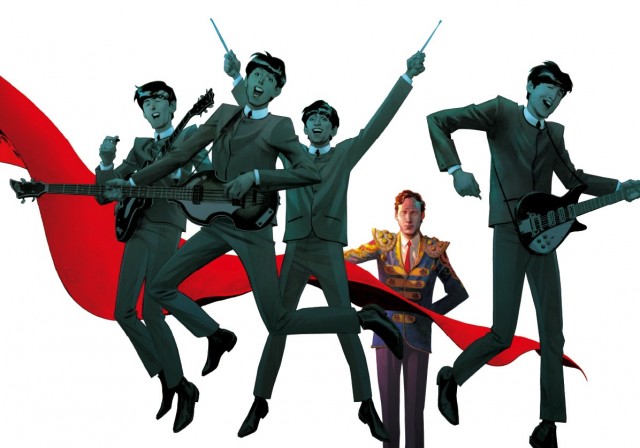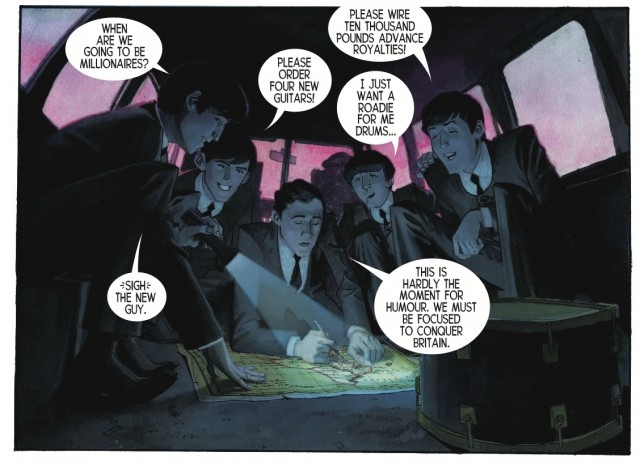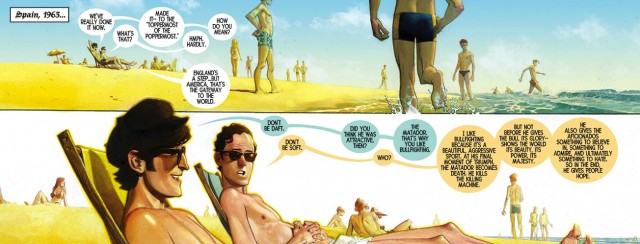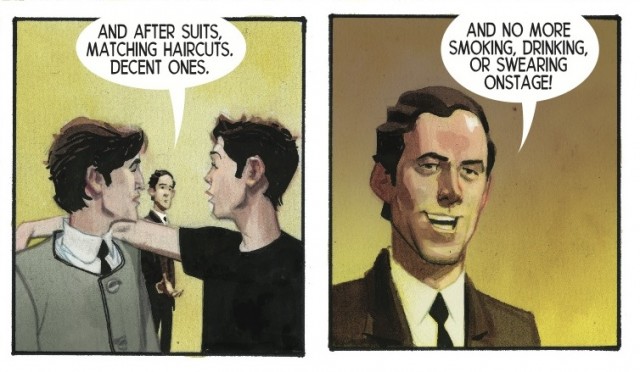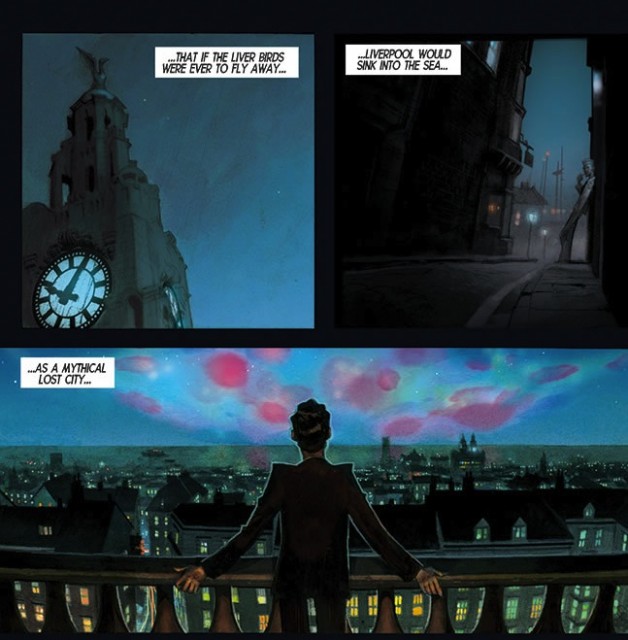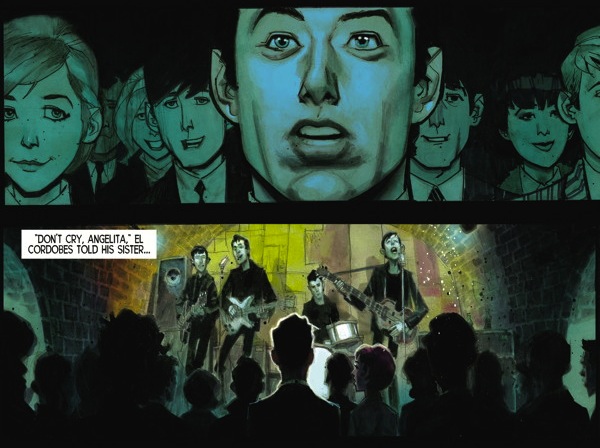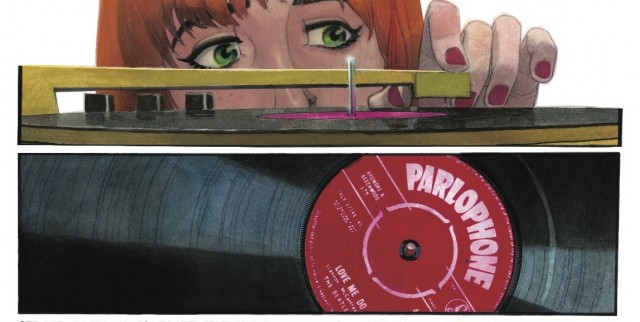Vivek Tiwary and Andrew Robinson’s The Fifth Beatle is a new graphic novel that tells the story of Brian Epstein, a man who discovered and managed The Beatles, and built them from a modestly popular local band into the most acclaimed and successful musical act of all time – but who remains shrouded largely in mystery, skimmed over in most Beatles histories, remaining in the shadow of the group whose fame he engineered.
This is a book that works on multiple fronts and appeals to many different audiences. It’s an essential purchase for any fan of The Beatles (or pop music history). It’s a meticulously-researched biography of a figure who reinvented the rules of the entertainment industry. It’s a story with themes of diversity and acceptance that feel especially pertinent in the here and now. And it’s an astoundingly well-crafted, beautiful comic.
And earlier this year, I had the chance to sit down with both Tiwary and Robinson to discuss the background of this project, their creative choices in adapting historic events to comic form, and their process of collaboration.
For those who may not be familiar with the man you’re writing about, who was Brian Epstein, and why write a graphic novel about him?
Vivek Tiwary: Brain Epstein was the man who discovered [The Beatles] when they were playing at The Cavern Club and were relative unknowns – they had a small fanbase in Liverpool and a little fanbase in Hamburg, but otherwise, the rest of the world couldn’t have cared less about them. No record label wanted to sign them, and he was the the first one to really believe. He used to go around Liverpool saying “The Beatles are going to be bigger than Elvis”, which was a ludicrous thing to say at the time. So it’s the story of that guy. The guy who took the band from obscurity and turned them into international superstars. And the human side of his story is that he was gay, and Jewish, and from Liverpool, and in the 1960s those were three significant obstacles. The Oscar Wilde laws were in place, so it was a felony to be gay; there was quite a bit of anti-semitism in the UK; and in Liverpool, there was nothing cultural going on.
So on the one hand it’s a really wonderful and untold Beatles story, but it’s also a very powerful and inspirational human story. And we’re very excited to be telling it. It’s one that should have been told decades ago, and we’re glad to be the ones telling it now.
Yes, it’s a story that everybody knows, but a side of that story that very few people know about. So, what research materials did you consult? There’s not a lot written about Brian…
Tiwary: There is one excellent book called “The Man Who Made The Beatles” by Ray Coleman that’s long been out-of-print, though you can find it used pretty easily. Brian wrote a quote-unquote ‘autobiography’ called A Cellar Full Of Noise, but he wrote this before The Beatles had recorded some of their best material – long before Sgt. Pepper’s – and, as I mentioned, it was a felony to be gay, so his homosexuality was kept very hidden and he doesn’t talk about his personal life at all. So that book…it reads more like a fan magazine. It’s useful for someone like me, to see how he talks, how he constructs sentences, his style – but in terms of learning about the facts and details of his life, it’s not very useful.
So, a large part of my research for this project was interviews. Tracking down people who knew him, getting them to open up with stories, and also being a little bit of a detective because a lot of people had differing memories, or probably had their own biases on how they want the story told. So it wasn’t just compiling the research and doing the interviews, it was figuring out who to believe, and how to believe them. But it was great fun, and people were very warm, and willing to talk about Brian.
I remember, as a kid, getting a copy of the revised edition of Hunter Davies’ authorized Beatles biography and how in the new introduction, he said how he regretted having had to hint around Brian Epstein’s homosexuality, and not being able to explicitly address the topic. And I found that fascinating – as a kid who’d read countless books about The Beatles, it wasn’t until this point that I realized how many things were left out of the “official” story…
Tiwary: Yeah! And sometimes people ask me “why now?”, why is this story being told now, and while as I said earlier, it should have been told decades ago, there is a certain timeliness to it. Because it was a felony to be gay in the 1960s, people who knew him intimately and cared about him didn’t talk about it. And so, for decades after that, they didn’t feel comfortable talking about it.
So I might also argue, it’s only been in the past ten years or so that – those folks are getting older, many of them are passing away, and Brian’s long gone, and they realize that if we don’t tell this story now, it’s going to be lost. And the world, we still have a ways to go, but we’re certainly much more liberal than we were then. So I think there’s people who are just willing to talk now that were not comfortable talking five or ten years ago.
Andrew Robinson: Sadly, they’re probably more open with their parents passing away and and other people they were hiding the secret from – and now that they’re gone, and these people are older, they can let it go and put it out there. I think we’re a lot more compassionate these days.
So then, Vivek- you have a background in the music industry and are probably best-known for your work as a theatrical producer. What drew you to this story, and what made you decide to tell it in comic format?
Tiwary: Well, the first part of that, why Brian Epstein – I discovered Brian Epstein’s story when I was in business school and dreaming about working in the entertainment business. And being a little academic, I thought I should study the lives of the great entertainment visionaries. I thought that The Beatles and Brian were the team that wrote and rewrote the rules of the pop music business, and so I thought that I should learn about Brian’s life. And I was stunned at how little information there was about him, and it became this mystery to uncover facts about his life, learn about his story, and tracking down people who knew him.
At the time, I wasn’t doing research for a script, I was just a young man looking for inspiration in the business. And I did uncover that story, how he managed them, got them a record deal, put them in their suits and their haircuts, and all that. And that’s a wonderful story, and it’s fascinating, and it’s all in the book – but it was the human side of his story that I’ve already touched upon, being gay, from Liverpool, and Jewish in a time when those were obstacles. That side of his story was incredibly inspiring to me.
I was born in New York, but my parents were born in Guyana South America, and their parents were born in India. So I’m a first-generation American, and you don’t see young people of my ethnicity working in entertainment fields. With the exception of Bollywood, which is a very specific thing, young Indian kids just don’t go into these kinds of businesses. And so, wanting to do that, and wanting to make a significant impact in those fields, and feeling like a little bit of an outsider, I could really relate to a lot of what Brian was probably feeling.
So, his story became one that’s very close to my heart, it’s a real labor of love project, so when I decided five or six years ago that I was looking for the next story to tell, I realized – it’s this one. It’s this one that I’ve been carrying around, and that I have an unusual amount of knowledge about, because I’ve done all this research.
So that’s why Brian. As for why a graphic novel – it’s true that this is my first graphic novel, but I grew up reading comics, I often say I probably learned to read by reading comics, and I mentioned that I’m academic, so I tend to be a little bit dorky about that…I’ve read comic scripts, and compared the scripts with the final products and so I was comfortable a little bit in that medium, even though I hadn’t worked in it. And when I thought of the story, I immediately thought in terms of color palate. It starts off in 1961 Liverpool, which is very dark grey industrial, very black and white if you will – and it ends in 1967 London, which is the birth of the Summer Of Love, the dawn of the psychedelic era, it’s very technicolor. So I saw it as a change of color. And so thinking of it in those terms, I immediately thought of the visual arts, which made me think of graphic novels. So that’s why graphic novel.
Robinson: I’m actually going to add a bit, talking about the story – I read the script for the first time, and thought “this is really interesting”. It’s a story about The Beatles, but it’s not about The Beatles. It’s like they’re background characters. We tell their story through their manager and what he went through. Because I think just retelling the Beatles story would be redundant, and this seemed like a fresh perspective on how The Beatles became what they are, but also deals with a personal story. Most of us aren’t going to live the lives that The Beatles lived, but I think almost everybody can relate to Brian Epstein. So that’s the beauty – there’s something in it for everybody. Even for people who say “hey, I’m not really a Beatles fan”, well, you don’t have to be. If you can feel for somebody who’s trying to do something amazing, and go up against great odds, then you’re going to like this story.
And how did you end up working together on this project?
Tiwary: We met through mutual friends…Andrew’s artwork is gorgeous, very painterly, and I knew I wanted a very painterly style. And when we met, and we discussed the story – not having worked in graphic novels before, it was clear that Andrew was somebody that I could be very collaborative with, who would talk through sequences with me, and that was very important to me. We got along very well, and saw the storytelling in the same way.
And then Andrew, as half of the partnership with more experience in the comics field, how much of a hand did you take in determining the flow of story, and making it work as a graphic novel?
Robinson: The story and the dialogue was pretty rock-solid. But for me, I feel like I got the freedom to go in there, and choose all the shots, decide how many panels were on a page, decide on the double-page spreads, and so visually, I had a lot of freedom. I would do breakdowns, we would approve the breakdowns, and then if there were changes to be made, for continuity or story wise, we made those changes and then just kept going. That was the beauty of it. I had a lot of freedom to experiment, and to just tell the best story that I could.
Vivek, you mentioned all the research you did for this project… Andrew, how did you go about getting the visuals to be similarly authentic, as you’re covering some aspects of the Beatles story that aren’t terribly well-documented?
Robinson: Well, it was really just a matter of researching all I could. The internet is a beautiful thing – finding Brian’s house, the appliance store where he worked, pictures of the Cavern Club. I compiled lists and photographs and made a lot of files. But then also, when I went to tell the story, I did my best to choose different angles, so I’m not just regurgitating famous photographs, but we’re actually seeing things. Instead of straight on, maybe we’re behind The Beatles. For instance, I had to research the interview with John Lennon when he’s apologizing for the “bigger than Jesus” comment, and I just found youtube videos but they’re all shot from straight-ahead, and it was John sitting with the rest of the band. But when you look in the book, I shoot it from the side, so we get this really cool profile of John as he leans down and gets really close to the microphone and has that apology moment. It’s things like that, where I’m trying to give, visually, a fresh perspective on a lot of images that we’ve seen a million times.
I love that visual metaphor of “showing a scene from behind The Beatles”, since that’s largely what the story is. You’re looking out from behind the group, you’re getting Brian’s perspective, and he was largely behind the scenes, looking out.
Tiwary: Exactly!
So, how much actual invention did you have to do in telling the story? Were there people you couldn’t find visual reference for? Did you end up bending or altering any true-life events for dramatic effect?
Robinson: There’s a character at EMI that I can’t remember if we used reference for. It just kind of worked out that he’s big and bulky…there’s echo storytelling, showing failures in Brian’s life. Art school, being in the military, and then here he is again, feeling very small, and being confronted by this large man and this large record corporation. So there’s this whole David vs. Goliath story archetype.
Tiwary: And even there, it’s not a fantasy sequence, but it’s close…it’s kind of seeing it through Brian’s eyes. So we might not have done reference for that, but we were thinking ‘this would be how he looked to Brian. Beyond that instance, I think every single character, we did real research for. I wanted to keep the facts intact, and tell the story that happened.
Building off the idea of seeing this story through Brian’s eyes – the sequence when Brian meets Colonel Tom Parker [Elvis Presley’s manager] gets pretty impressionistic and fairly terrifying.
Robinson: Yeah, I think in the script, Vivek was describing that in certain panels Colonel Parker’s teeth would be sharpened, almost like he’d be a creature of the night, a vampire, a bloodsucker. I thought that was great, and I was thinking ‘why not push this a bit further’? So in that sequence, when we see Colonel Parker, behind him, The Plaza Hotel is almost ablaze. The plants are wilting and dead, there’s smoke coming off of him and the other people, almost as if you’re in hell. But then when the scene changes and we see Brian from the atrium, there’s this light, this blue heavenly light coming down and hitting Brian – so we’re kind of juxtaposing Brian and his management skills, and how he feels about the Beatles, with Colonel Parker. And we all know…well, most of us know how he treated Elvis, taking 50%, all that. So it’s sort of good vs. evil in the Plaza Hotel. Taking this conversation, which is very interesting, and then upping it with the visuals.
And also, since we’re dealing with Brian’s drug addiction, I also wanted to play with that – maybe he’s hallucinating a little bit, and we’re seeing some of his impressions.
That brings us back to a thing that came up earlier, the use of color and visual cues to convey the emotions and mood of the story, the less literal aspects of the storytelling.
Robinson: Well, one thing is in darker or nighttime scenes, I chose to have all the gutters [the space between panels in a comic page] be black – but then, if we had warmer scenes, the gutters are white. So there’s things I could play with. Changing the value of the colors, and accenting what’s going on in the script and dialogue. I’m just trying to stand behind the dialogue, and compliment it as much as I can, with the light and the dark. And as Vivek said, we start off in Liverpool and it’s grey and boring, as if nothing ever really happens here…people don’t get to live their dreams. And then as soon as Brian goes to The Cavern for the first time, and when he actually sees The Beatles, then all of a sudden, BOOM, here comes the color.
To take that idea even further, Kyle Baker also has a sequence in this book, which is a huge stylistic shift from the rest of the narrative.
Tiwary: Yes, Kyle does a seven page sequence toward the end of the book that covers the point when The Beatles went to the Philippines, and in the Philippines, things got really out of control. They inadvertently snubbed Imelda Marcos, and she pulled their security, and the Filipino army literally chased them out of the country, they had to get a plane to fly them out and army jeeps were chasing them down the tarmac. This all really happened, and this was also about the same time that John Lennon’s “bigger than Jesus” comment landed in America, so they started burning records in America…so I felt, not terribly different than thinking “Colonel Parker was a bloodsucker, so let’s depict him as a vampire”, stuff for The Beatles at this point in their career started to get very cartoonish. So I thought, let’s do this sequence in a very cartoony style!
And I’ve been a fan of Kyle’s work, he’s a New Yorker and I’m a New Yorker so we’ve known each other for a while, and he grew up watching those old Beatle cartoons. So it was just a nice aligning of interests and excitements about that. So he does this seven-page sequence that is sort of a tribute to the old Beatles cartoons. And it’s very, very different from Andrew’s style, which is something I wanted. I wanted it to almost feel like an insert, like it didn’t really belong in the book but got kind of shoved in.
And the Graphic Novel isn’t the only aspect of this project, correct?
Tiwary: That’s correct! We are in pre-production of a film, and we have secured rights to Beatles music, we got the approval of the band and signed a deal with Sony/ATV who control the music publishing, and we are the first film about the band in history to have secured their approval, to get those rights, so that’s very exciting for us. So between having this gorgeous graphic novel and the music rights, there’s a lot of excitement in film industry circles, in Hollywood and the UK.
So, this project has the approval of The Beatles and Apple, if they’re permitting you use of the music?
Tiwary: In order to get the rights, Apple Corps had to approve the script, so they are all very aware of the project. When I decided I wanted to tell this story, the very first thing I did was I flew to Liverpool and this might sound a little crazy, but the first thing I did was tracked down the cemetery, and I sat down and asked Brian’s permission. It just felt like the right thing to do. And then I sat down with the living, with his estate, and made sure they were comfortable with me and liked me and were amenable to the approach that I was taking. This is not officially an authorized biography, it’s not endorsed by the estate, but they have been huge supporters and very helpful in terms of the interviews and memorabilia and stuff like that. The did not want to get in the way of my being able to tell the full truth, warts and all, and so they didn’t want it to look like they were whitewashing anything. Which is great!
And then the next thing I did was I contacted The Beatles [Paul McCartney, Ringo Starr, Olivia Harrison, and Yoko Ono]. And I joked at the time, I said “I’m not asking for anything, and I’m sure I’ll call you back someday and ask for something, but today I’m not – I’m really just letting you know that I exist and that I’m working on this, and that I have the support of the estate. Here’s my background, here’s what I’ve done, and I just wanted to let you know that I’m working on this film and graphic novel about Brian.” And they all got back to me, either through their managers, publicists, or attorneys, and said “thank you for letting us know, good luck with your project”, and periodically over the years, I’d keep feeding them information about what was happening with the book. So the two Beatles and Yoko Ono and Olivia Harrison have been kept in the loop pretty regularly.
Did you have any concerns about how best to structure the narrative, since you’re dealing with unfamiliar aspects of a familiar story? Everyone knows the beats of the Beatles story, so did you make an effort to utilize those moments, to give context to the parallel events in Brian’s life?
Tiwary: Well, it is Brian’s story, but certainly what draws the audience in is wanting to know the – the ‘Inside The Music’, I guess? The stories behind the key beats of the Beatles story, so you do follow a lot of the key Beatles moments, but view it from Brian’s perspective. But at the same time, it is about him, and what makes him tick, so I didn’t really feel that I needed to be too slavish to Beatles history. It was more about looking at Brian’s life as a whole, and sort of outlining what I saw as the key beats in that. And in many cases, that overlapped with key beats of Beatles history. In some cases, it didn’t. There are stories of Beatles history, like Pete Best for example – I think it would be irresponsible to not tell the Pete Best story if your overarching goal was to tell the Beatles story, but I don’t think it’s irresponsible to marginalize the importance of that if you’re telling the Brian Epstein story. I don’t think an understanding of Pete Best in integral to understanding Brian Epstein.
So you have a certain freedom, in being able to guess that most people who pick up this book will already know the arc of the Beatles story. They already have a way in. But were there moments where, to make sure readers didn’t lose their place in the timeline, you felt a need to refer to what was happening in The Beatles’ world, even if Brian wasn’t involved at that moment?
Tiwary: I did have the benefit of knowing that people will go into this story knowing some of it, knowing the rough outline and wanting to know more of the nuances, so I did have that… But no, I didn’t really feel the need to check in with The Beatles, or tie them in more than they are. They’re a big part of this story, but what we’re doing is focusing on Brian, and telling the parts of the story that haven’t been told.

